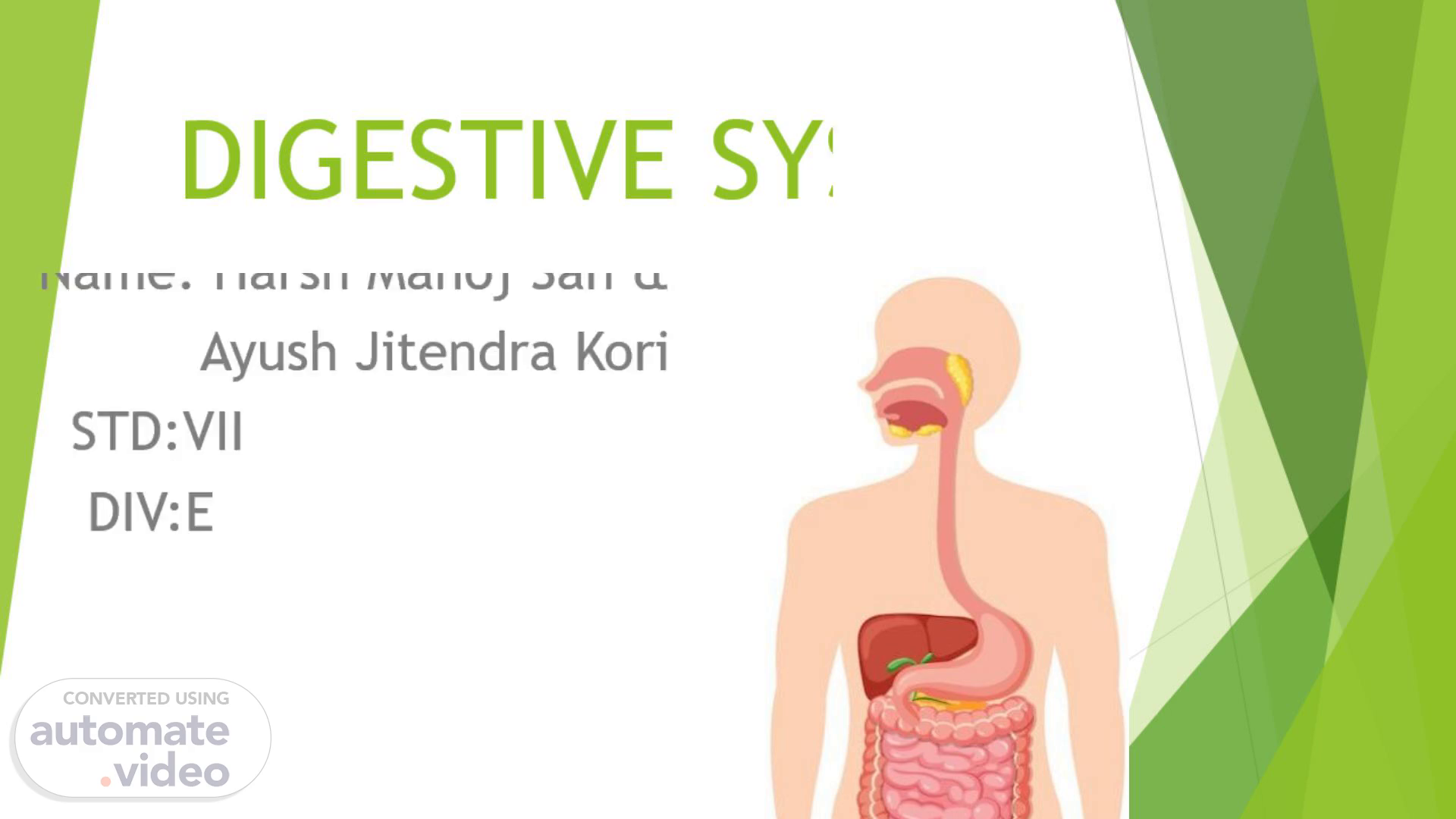Scene 1 (0s)
Name: Harsh Manoj Sah &. DIGESTIVE SYSTEM. Ayush Jitendra Kori.
Scene 2 (12s)
Digestive System. Conversion of food into a soluble form and its absorption into the blood is called digestion. The digestive system consists of the alimentary canal and digestive glands. The total length of alimentary canal is about 9 metres. Its main parts are the mouth, pharynx, oesophagus, stomach, small intestine, large intestine, rectum and anus. The salivary glands, liver and pancreas are the digestive glands connected to the alimentary canal. Different organs of the digestive system systematically perform the function of digestion. There are different stages in the process of digestion of food and at each stage there is a different organ of the digestive system which performs its specific role. Let us study the structure and function of each organ of the digestive system..
Scene 3 (45s)
Learn a new word. Enzymes are substances secreted in the body of an organism, which bring about specific chemical reactions. They act as catalysts. Digestive enzymes of the digestive system bring about changes in the food materials. Metabolic processes are impossible without enzymes. Enzymes are a specific type of proteins. They are most active at normal body temperature..
Scene 4 (1m 3s)
Teeth. The process of digestion begins with the function of the teeth in the mouth. There are four types of teeth, namely, incisors, canines, pre-molars and molars. Each type of tooth has a specific function. Each tooth is covered by a hard substance called enamel. Enamel is made of a calcium salt. Saliva contains an enzyme called ptyalin or salivary amylase. Ptyalin converts starch into a sugar called maltose..
Scene 5 (1m 24s)
Digestive System. 12.5 Digestive System. Mouth. Pharynx/Throat.
Scene 6 (1m 36s)
Mouth. Digestion of food begins in the mouth. Food is chewed with the help of teeth into very small pieces..
Scene 7 (1m 48s)
Pharynx/Throat. The oesophagus and trachaea open into the pharynx..
Scene 8 (1m 56s)
Liver. The liver is the largest gland in the body. It has a rich supply of blood. Its main function is storage of glucose. The gall bladder is situated below the liver. It stores the bile, the digestive juice secreted by the liver. When bile is carried into the small intestine, it mixes with the food there and helps in the digestion of fats. Bile contains bile salts..
Scene 9 (2m 17s)
Small Intestine. The small intestine is about 6m long. Most of the digestion and absorption of food takes place here.Three different digestive juices are mixed with the food in the small intestine. Absorption into the blood, of nutrients obtained by the digestion of food, also occurs in the small intestine..
Scene 10 (2m 35s)
Large Intestine. The large intestine is about 1.5m long. Only water is absorbed in the large intestine. A small part called the ‘appendix’ is attached to the first part of large intestine. Undigested remains of the food digested in the small intestine enter the large intestine.Undigested material is thrown out of the body through the anus..
Scene 11 (2m 53s)
Stomach. The large sac-like part of the alimentary canal is called the stomach. The gastric glands of stomach secrete gastric juice. Food that has entered stomach is churned. Three components of gastric juice, namely,hydrochloric acid, pepsin and mucus are mixed with food here and it become acidic. Mainlyproteins are digested in the stomach. Due to the churning and the action of gastric juice, food becomes a semi-solid slurry which is slowly pushed into the small intestine..
Scene 12 (3m 17s)
Pancreas. The pancreas secretes the pancreatic juice that contains various enzymes..
Scene 13 (3m 25s)
Oesophagus. It is a tube leading from the pharynx to the stomach. It pushes the food towards the stomach..
Scene 14 (3m 35s)
Salivary Glands. Saliva is produced in the salivary glands in the mouth cavity, located in front of the ears, near the pharynx and below the tongue. It is carried to the mouth via ducts. It is mixed with food during the process of chewing..
Scene 15 (3m 51s)
Important Glands of the Digestive System, their Secretions and Functions.
Scene 16 (4m 17s)
Are we putting our health at risk?. Physical health is extremely important in personality development. When all our organ systems function properly, we say that we are in good health. However, harmful habits like smoking, chewing of tobacco, drinking alcohol affect our health adversely..
Scene 17 (4m 34s)
Effects of tobacco, alcohol, smoking, on the digestive system.
Scene 18 (5m 2s)
My Role. Making pictures and slogans against tobacco consumption, smoking, drinking alcohol, etc. And displaying them in the classroom and the neighbourhood. Keeping a watch on whether one’s surroundings are tobacco-free. Composing an oath against addiction and taking the oath in the class and also during assembly. Making parents and teachers aware of such instances in the neighbourhood..
Scene 19 (5m 23s)
Important Days. Thank You.
